The Mexican Modernists
Study Center
Works on view in MMoCA’s Galleries are marked as “On View.” Other works in the collection are not on display to the public.
The Madison Art Center (now the Madison Museum of Contemporary Art, or MMoCA) received a transformative gift of over 1,000 works of art in 1968 from local collectors Rudolph and Louise Langer. The gift included nearly 200 works by modern artists working in Mexico, many of which were acquired there after a long drive down from Wisconsin. The collection highlights major themes in Mexican modern art created in response to the turmoil and promises of the Mexican Revolution (1910–20) and its role in the changing notions of national identity and history during the postrevolutionary period. From landscapes of the Mexican countryside and imaginings of the Indigenous past to surreal, apocalyptic images of torment and the valorization of Mexican cultural traditions, the artwork from this period inspired a nation and fortified new generations of artists.
El Madison Art Center (ahora Madison Museum of Contemporary Art, MMoCA) recibió en 1968 una donación transformadora de más de 1,000 obras de arte provenientes de los coleccionistas locales Rudolph y Louise Langer. La donación incluía casi 200 obras de artistas modernos activos en México, muchas de las cuales fueron adquiridas tras un largo viaje en coche al vecino país desde Wisconsin. La colección destaca algunos de los temas más importantes del arte moderno producido en México en respuesta a las dislocaciones y promesas de la Revolución Mexicana (1910–1920) y su papel en la transformación de nociones de identidad e historia nacionales durante el periodo posrevolucionario. Desde paisajes de la provincia mexicana y simbolizaciones del pasado indígena, hasta imágenes tormentosas, surreales y apocalípticas, junto a la valoración de las tradiciones culturales mexicanas, el arte de este periodo inspiró a una nación y fortaleció a nuevas generaciones de artistas.
Artworks on View
Currently, no artworks from the Mexican Modernist collection are on view.
Artists
David Alfaro Siqueiros
Lola Cueto
Frida Kahlo
Frida Kahlo was one of the most important painters of the Mexican modernist movement, which thrived in the years between World War I and World War…
Fanny Rabel
Diego Rivera
José Clemente Orozco
Definiendo tradiciones reclamando pasados
El concepto posrevolucionario de la mexicanidad –fundamentado en la renovación y reconocimiento de las tradiciones populares y culturas regionales de México y frecuentemente anclado en visiones idealizadas del pasado indígena– alimentó tanto la reflexión de los artistas en torno a la sociedad mexicana como sus contribuciones al nacionalismo cultural del periodo.
Defining Traditions Reclaiming Pasts
The postrevolutionary concept of mexicanidad—the renewal and recognition of Mexican popular traditions and regional cultures, often understood to be anchored in a romanticized Indigenous past—informed modern artists’ reflections on Mexican society and shaped their contributions to the cultural nationalism of the period.
Cabeza II (Pesar) / Head II (Grief)
Rufino Tamayo
c. 1926-28
grabado en madera a fibra sobre papel / woodcut on paper
15 1/2″ x 12 3/4″
Credit
Donación de Rudolph y Louise Langer / Bequest of Rudolph and Louise Langer
Identidad y pertenencia
Artistas mexicanas modernas plantearon preguntas persistentes en torno a la problemática de la identidad en México y los Estados Unidos. ¿Quién amerita pertenecer y tener lugar dentro de una sociedad? ¿Quién merece ser representado dignamente, para quiénes y con qué propósito?
Identity and Belonging
Mexican modern artists raised long-standing questions around issues of identity in both Mexico and the United States. Who is deemed to belong, to have a place within a society? Who is worthy of dignified portrayal, and for whom and to what purpose?
La mujer del rebozo rojo / Woman with Red Shawl
Celia Calderón
1953
litografía en color sobre papel / color lithograph on paper
16 1/2″ x 13 1/2″
Credit
Donación de Rudolph y Louise Langer / Bequest of Rudolph and Louise Langer
Trabajo y vida cotidiana
Los temas relacionados con la cotidianeidad —con el trabajo, la familia, el sustento, las celebraciones y los hitos de la vida— fueron elementos básicos para gran parte del arte mexicano en las décadas posteriores a la Revolución. Las escenas rurales y de costumbres regionales dominaron el arte mexicano de esta época, visualizando a la nación mexicana en una mayor diversidad y estableciendo paralelos con los esfuerzos del gobierno posrevolucionario por expandir nociones de ciudadanía e identidad.
Labor and Daily Life
Themes related to everyday life—work, family, sustenance, celebration, and life’s momentous occasions—became staples of much Mexican art in the decades after the Revolution. In Mexico rural scenes and regional folkways dominated during this period, and envisioning the Mexican nation in greater diversity paralleled the postrevolutionary government’s efforts to expand notions of citizenship and identity.
Escuela al aire libre / Open Air School
Diego Rivera
1932
litografía sobre papel / lithograph on paper
15 11/16″ x 22 1/2″
Credit
Donación de Rudolph y Louise Langer / Bequest of Rudolph and Louise Langer
Paisaje y territorio
En el siglo xix, el paisaje mexicano fue asumido como símbolo nacional en las artes visuales, más señaladamente en la obra de José María Velasco. Sin embargo, entre los artistas modernos sólo muy pocos fueron paladines del género. Casi siempre, las imágenes de la naturaleza or la ciudad adquieren significado a través de la incorporación de la acción humana, acorde con una sociedad en transformación humano durante el periodo posrevolucionario.
Landscape and Territory
In the nineteenth century, the Mexican landscape was taken up as a national symbol in the visual arts, most emblematically in the paintings of José María Velasco. Yet among modern artists only a few continued to champion the landscape genre. More often, images of nature or the city acquired meaning through the incorporation of human action, in keeping with a society in transformation during the postrevolutionary period.
En el Mezquital / In the Mezquital
Fanny Rabel
1954
grabado en linóleo sobre papel / linocut on paper
16″ x 23″
Credit
Donación de Rudolph y Louise Langer / Bequest of Rudolph and Louise Langer
Surrealismo
El surrealismo, la vanguardia literaria y artística fundada por André Breton en París en 1924, extendió su influencia más allá de las fronteras de Europa durante la década del 1930. A pesar de que durante este periodo hubo conexiones sustanciales entre México y Europa a través de intercambios intelectuales y migraciones artísticas, la mayoría de los artistas mexicanos se ocuparon del desarrollar sus propios estilos y formas innovadoras. Ello a veces resultó en sorprendentes coincidencias estilísticas con los surrealistas. Mucho antes de que Breton visitara México en 1938, y de que se acercara a varios artistas mexicanos para que participaran de su movimiento, Artistas mexicanas modernas habían desarrollado por cuenta propia una estética afín a las preocupaciones surrealistas.
Surrealism
Surrealism, the avant-garde literary and artistic movement founded by André Breton in Paris in 1924, expanded its reach beyond Europe in the 1930s. While there were substantial connections between Mexico and Europe during this period through both intellectual exchanges and artistic migrations, most Mexican artists focused on developing their own innovative styles and forms, which at times yielded surprising stylistic commonalities with the Surrealists. Long before Breton first visited Mexico in 1938, and approached numerous artists to participate in the movement, Mexican modern artists had separately developed an aesthetic akin to Surrealist preoccupations.
Pitahayas
Frida Kahlo
1938
óleo sobre aluminio / oil on aluminum
29 1/4″ x 33 1/4″ (framed)
“It is fuchsia on the outside and hides the subtlety of a whitish-gray pulp flecked with little black spots that are its seeds inside. This is a wonder! Fruits are like flowers: they speak to us in provocative language and teach us things that are hidden.”
—Frida Kahlo
Drawn from the artist’s garden, Pitahayas refers to the five bright pink fruit in the center of the composition. Kahlo painted the arrangement on a piece of metal in the style of an ex-voto—a small devotional painting on tin in the Mexican folk art tradition. These religious paintings were typically commissioned by a person giving thanks to a saint or divine entity after suffering from an illness or experiencing tragedy. Kahlo had a large collection of ex-votos that covered the walls of her home and studio.
In this context, Kahlo’s unassuming still life can be read as a personal allusion to her rise from tragedy that culminates in immense gratitude for her life and successful artistic career. The personal iconography she imbued in her work often referenced the intense physical pain she endured as a result of contracting polio in 1913, a tram accident in 1925, and suffering multiple miscarriages. Within this framework, Kahlo often depicted vegetation as a symbol of fertility and regeneration. She also drew directly from medical textbooks—one of the pitahayas is sliced directly in two and mirrors a dissected cell undergoing cellular division. Throughout this small oil painting are references to the artist’s preoccupation with the life cycle, regeneration, and her conviction that life fertilizes death.
Pitahayas evolved over time and in 1939, upon her return from exhibiting in Paris, she learned her husband, fellow artist Diego Rivera, wanted a divorce. Kahlo changed the expression of the skeleton from a smile to a frown. Much like the pitahaya, with its delicate, fleshy center concealed inside a bright pink exterior, Kahlo embedded a deeply personal history in this painting, suggesting the work is not only a still life, but an intimate self-portrait.
Credit
Donación de Rudolph y Louise Langer / Bequest of Rudolph and Louise Langer
Revolución, guerra y protesta
Más que las imágenes de los famosos líderes de la Revolución, los impresos gráficos mexicanos de las décadas del 1920 y del 1930 representaron la humilde heroicidad de la gente común. Ya con distancia histórica del conflicto, en ellos se visualiza la tenacidad popular a la par que se reconoce el sufrimiento, las dislocaciones e inmensa pérdida de vidas ocasionados por diez años de revolución y guerra civil.
Revolution, War, and Protest
More often than images of famous leaders of the Revolution, Mexican prints of the 1920s and 1930s featured the humble heroics of common people. Made at an historical distance from the conflict, they envision popular resilience, while also acknowledging the sorrow, dislocation, and immense loss of life over the ten years of revolution and civil war.
La retaguardia / Rear Guard
José Clemente Orozco
1929
litografía sobre papel / lithograph on paper
16 7/8″ x 22 3/4″
Otro sección de la exposición aborda imágenes de la Revolución Mexicana, asi como la guerra y la protesta en contextos nacionales e internacionales. La retaguardia de Orozco despliega una serie de figuras anónimas pero reconocibles. Es ésta una estrategia visual que él ya había usado repetidas veces en su ciclo mural de la Escuela Nacional Preparatoria de la Ciudad de México (1923–26), y otras obras sobre temas de la Revolución. Un grupo de campesinos combatientes en retirada —con preeminencia de las soldaderas, que fueron las mujeres que acompañaron a las tropas y participaron de las luchas armadas durante el conflicto— se prepara con evidente desánimo para la siguiente batalla. Aunque se trata de pequeños detalles, el niño cargado a hombros por un hombre y la soldadera que acuna el pie de un bebé ofrecen señales de esperanza.
_____
Another exhibition section focuses on scenes of the Mexican Revolution, as well as on war and protest in both national and international contexts. Orozco’s Rear Guard deploys anonymous yet recognizable figures, a visual strategy he had used repeatedly in his mural cycle at the National Preparatory School in Mexico City (1923–26), and in other works related to the Revolution. The receding group of peasant combatants—most prominently soldaderas, women who accompanied the troops and participated in armed struggle during the conflict—sets off for the next battle with weary resolve. Yet small touches, the boy propped on a man’s shoulder and a soldadera cradling a baby’s foot, offer signs of hope.
Credit
Donación de Rudolph y Louise Langer / Bequest of Rudolph and Louise Langer





